Propaganda’s scalpel: How Russian lies fracture Ukraine
The Kremlin uses censorship, disinformation, and digital control to create an alternate reality in Ukraine's occupied regions, with the goal of dividing Ukrainians and weakening resistance.
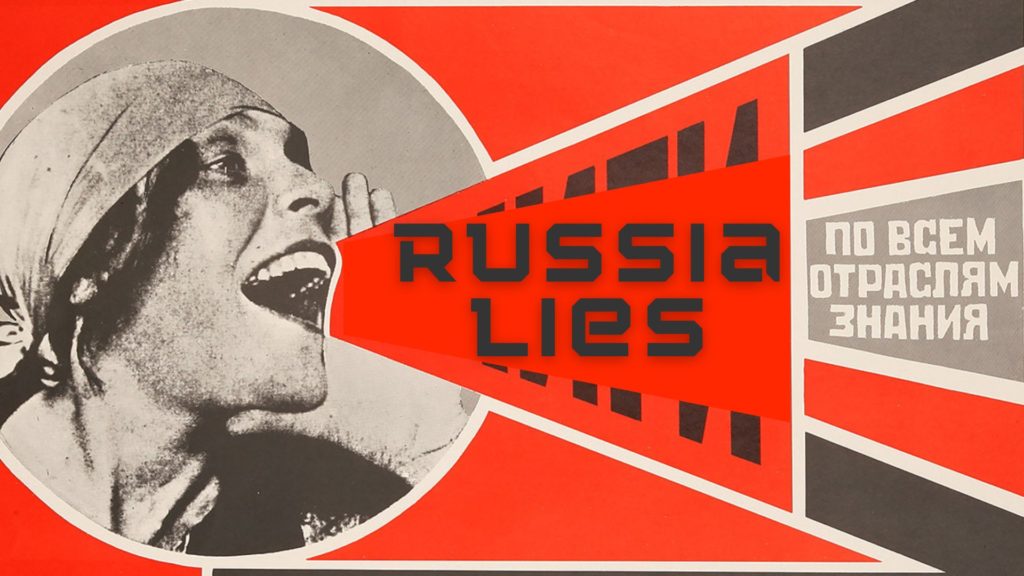

Throughout Ukraine’s independence, Russian influence has been amplified by Russian media, pro-Russian politicians, and linked Ukrainian media outlets. Manipulative information targeting Ukraine has become more systemic, aggressive, and targeted over the years.
The 2022 full-scale invasion escalated Russian disinformation further. While the war reduced openly pro-Russian actors in government-controlled territories of Ukraine, Russian disinformation became full-blown propaganda in occupied territories.
Russia aims to deepen the divide between Ukrainians in Russian-occupied territories and those in free Ukraine. This strategy seeks to undermine trust in Ukraine among residents in occupied areas and weaken resistance to the occupation. It also aims to pressure the Ukrainian leadership, amidst societal strain, to abandon efforts to liberate the occupied territories.
The new report Revealing Russian Influence in Europe by the Institute of Innovative Governance identified 105 active pro-Kremlin voices in Ukraine, mapping Russia’s network of influencers in media and digital platforms.
The report empowers Euromaidan Press to call out Russian influencers, increasing awareness and resilience. A case from free Ukraine demonstrates effective strategies against Russian propaganda. Meanwhile, Russia’s colonial policy in occupied territories sheds light on its imperial playbook.
In total, the report has identified 360 pro-Russian lobbyists active in Germany, France, Italy, and Ukraine. Their common goals are undermining sanctions on Russia and weakening support for Kyiv. For specifics on the web of Russian influence uncovered in Germany, France, and Italy, see Euromaidan Press’ past coverage here, here, and here.
5 Russian lies targeting Ukraine
Russia intensified its disinformation campaign against Ukraine after the 2004 Orange Revolution and the 2014 Crimea annexation, promoting anti-Western narratives and historical manipulations through key pro-Russian media actors. These included TV channels linked to pro-Russian politician Viktor Medvedchuk, online outlets like Strana.ua, and social media accounts spreading five core false narratives about Ukraine:
- Ukraine is a fascist/Nazi state;
- Ukraine is Russophobic;
- Ukraine is a failed state;
- Ukraine is a Western puppet;
- Ukraine is historically Russian land.
The 2022 invasion escalated Russian disinformation with increased dehumanization, hate speech and genocidal rhetoric directly linked to violence. The war reduced overt pro-Russian actors in government-controlled Ukraine, but Russian state propaganda remains systematic in occupied territories through official channels, creating a divergent information landscape requiring further study, says co-author of the Revealing Russian Influence in Europe report Oleksandra Tsekhanovska.
“In occupied territories, both long-standing and recent, Russian propaganda, not just disinformation, is systematically orchestrated through government and non-government channels, creating a drastically different information landscape compared to free Ukrainian territories,” Tsekhanovska told Euromaidan Press.
The researcher emphasizes that Western analysts often underestimate the depth and scope of Russian influence in Ukraine, lacking the full context to comprehend the situation.
“A person analyzing Russian disinformation, for example, in Paris, Berlin, or Rome, cannot comprehend the full context, depth, and scope of Russian influence in Ukraine,” explained Tsekhanovska.
The report aims to identify propagandists not yet targeted by Western sanctions, underscoring the importance of understanding the comprehensive nature of Russian disinformation in Ukraine.
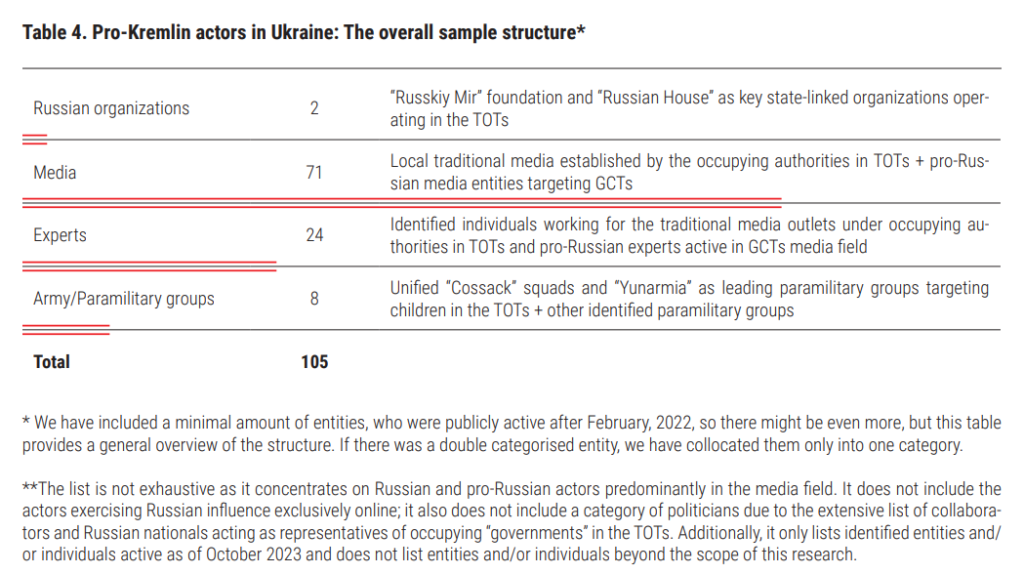
Russian influence in the government-controlled territories of Ukraine
Before the full-scale invasion, over half of Ukraine’s pro-Russian content came from TV channels ZIK, 112, and NewsOne, formally owned by Taras Kozak, an MP from the pro-Russian Opposition Platform – For Life party and an ally of Viktor Medvedchuk, Putin’s closest associate in Ukraine. Medvedchuk, whose daughter has Putin as a godfather, was widely believed to be the true owner of these channels.
A pre-invasion monitoring report revealed 12 narratives promoted by these TV channels, aligning with key messages of Russian propaganda in Ukraine:
- Ukraine is a failed state;
- Ukraine is a fascist/Nazi state;
- Ukraine is a Western puppet;
- Medvedchuk is Ukraine’s only hope;
- Only friendship with Russia can “save” Ukraine;
- Russia is not a part of the occupation/war in Ukraine, there is a civil war;
- Ukraine is to blame for Russia’s annexation of Crimea;
- Zelenskyy betrayed his voters;
- Zelenskyy is a continuation of Poroshenko’s policies;
- The Orthodox Church of Ukraine consists of Orthodox splitters;
- The Euromaidan protests were a mistake;
- There is a threat of a coup in Ukraine.
The invasion dramatically shifted Ukrainian public sentiment, with pro-Russian positions becoming untenable.
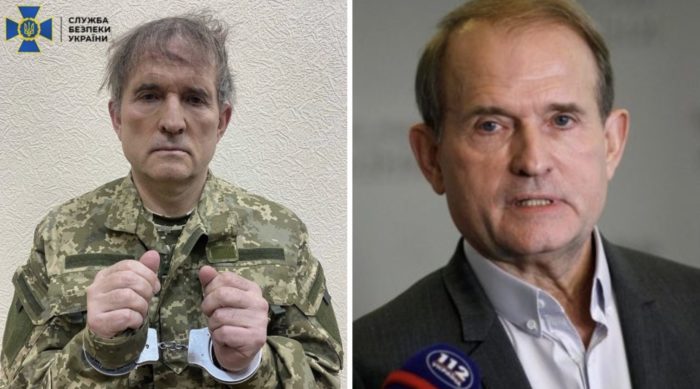
Medvedchuk-related TV channels closed, but some linked political analysts maintained their stance. They became commentators for Russian propaganda on personal Telegram and YouTube channels led by former colleagues like Oleksandr Shelest and Max Nazarov.
These analysts include Denys Zharkikh, Kyrylo Molchanov, Olena Bronytska, Pavlo Karnazytsky, Glib Prostakov, Vasyl Stoyakin, Oleksandr Skubchenko, Vasyl Vakarov, Dmytro Perlin, Olena Markosyan, Andrii Mishyn, Dmytro Korniichuk, Dmytro Spivak, Kost Bonadrenko and others.
Pro-Russian media actors Anatolii Shariy, Svitlana Kriukova, Ihor Guzhva (owner of banned outlet Strana.ua), and Olesya Medvedeva (host of Strana.ua’s “Yasno.Ponyatno” YouTube program) have adopted an ambiguous post-invasion approach, criticizing the war while pushing milder pro-Russian messages on “Russophobia.”
Notorious pro-Russian blogger Anatolii Shariy, under Ukrainian sanctions and suspected of treason, has lived in the EU for over a decade. In 2012, Lithuania granted Shariy refugee status but later revoked it. In 2019, he created a political party that gained seats in several city councils.
Shariy’s audience has grown since the invasion, attracting those with mildly pro-Russian views who are skeptical of the Ukrainian government. His content now focuses on corruption allegations and discrediting the Ukrainian armed forces. In particular, he spreads fake news claiming that Ukrainian soldiers are selling Western weapons to the Russians.
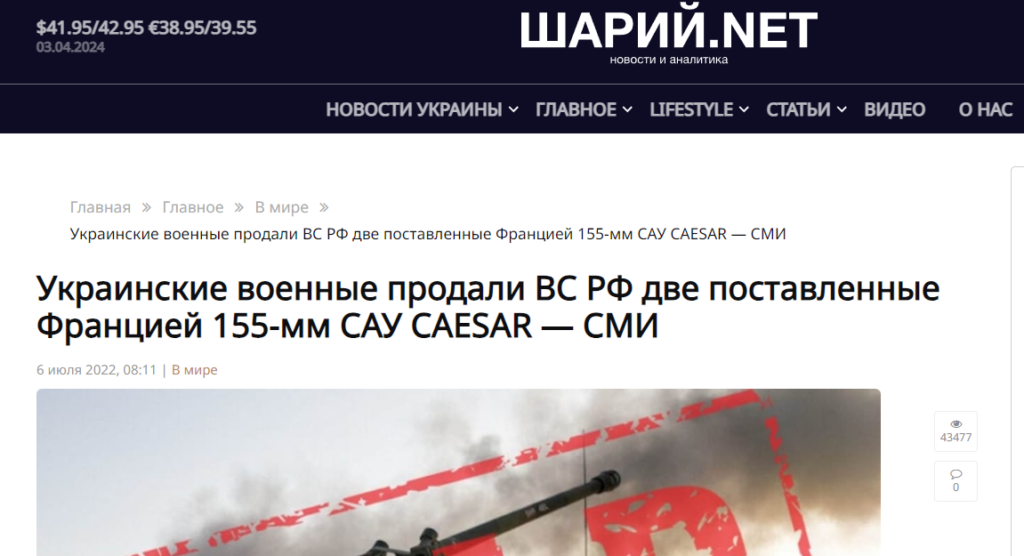
Having been absent from Ukraine for over a decade, Shariy openly despises the country, portraying it as a failed state undeserving of statehood due to its leadership by a “semblance of a president.”

In contrast, individuals associated with Viktor Medvedchuk’s larger pro-Russian project have vanished from the public eye following his arrest and exchange to Russia in 2022. Medvedchuk’s NGO, Ukrainskii Vybir (Ukrainian Choice), had been a major vessel for Russian interests in Ukraine since 2012, advocating for Kyiv to abandon EU integration and join the Russian-led Customs Union.
Some individuals within this network were cooperating with Russia on the ground, with a Ukrainskii Vybir leader arrested in May 2022 for allegedly preparing to overthrow the constitutional order. Despite reduced visibility, this network remains a potential threat to Ukrainian statehood.
“Despite Russia’s narrowing scope in Ukraine after 2014, Russian disinformation adapted by finding new channels to spread key narratives, fake news, and manipulations. Adaptability and a systematic approach define Russian disinformation,” Tsekhanoska said.
The Ukrainian Orthodox Church of Moscow Patriarchate (UOC MP), an integral part of the Russian Orthodox Church (ROC) until 2022, has long been a channel for Moscow to exert destabilizing influence in Ukraine.
Although not all UOC MP representatives support Russia against Ukraine, the church has a history of pro-Russian activities at various levels. In May 2022, the UOC MP pursued “administrative separation” from the ROC due to the latter’s support of the Russian invasion. However, this move is insufficient to eliminate Russian influence, as many individuals linked to the UOC MP continue to disseminate anti-Ukrainian rhetoric and activities, with some priests acting as saboteurs, artillery spotters, and intelligence agents for Russia.
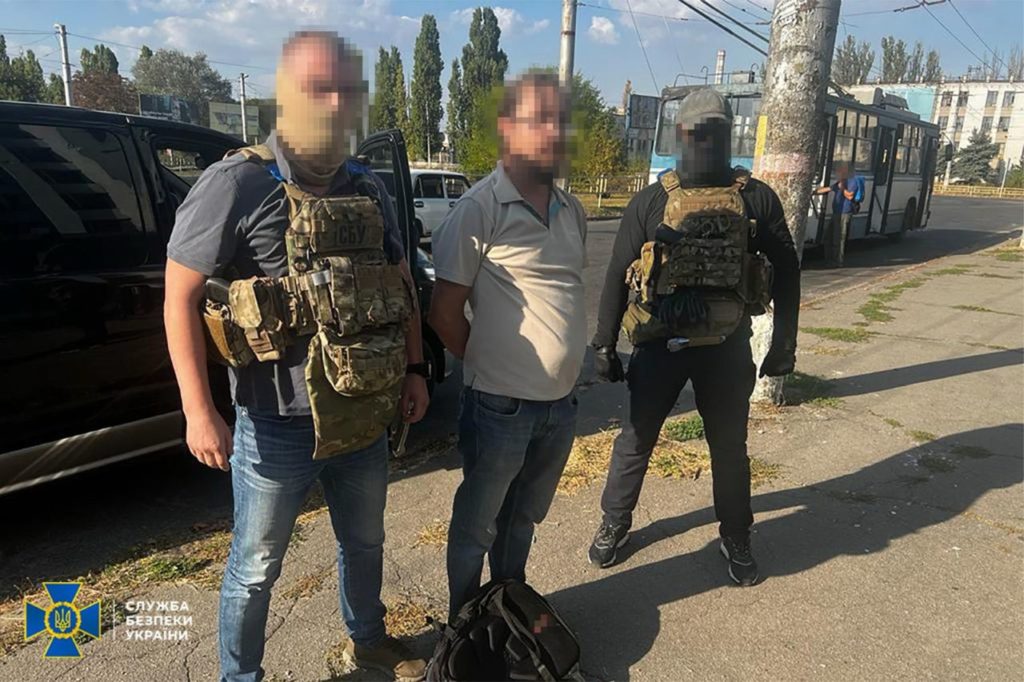
The actions of pro-Russian actors in government-controlled regions of Ukraine carry two main consequences.
- Directly, individuals linked to groups like Ukrainskyi Vybir, Sharii’s Party, and the UOC MP may cooperate with Russian military and intelligence, engaging in sabotage, artillery spotting, or providing sensitive information – posing immediate threats to Ukrainian civilians and troops.
- Indirectly, while not overtly siding with Russia, these actors shape wartime opinions by promoting Kremlin narratives aimed at demoralizing, dividing, and polarizing the Ukrainian population. While less visible, such efforts erode societal resilience, profoundly undermining Ukraine’s ability to resist the invasion.
The Kremlin is waging an aggressive disinformation campaign to discredit and disrupt Ukraine’s mobilization efforts, pouring significant resources into producing slick propaganda. One notable example is a professionally-crafted video featuring Russian actors with a Ukrainian voiceover, designed to sow confusion and undermine public support for Ukraine’s defense of its homeland.
в телеграме сегодня появился очень мерзкий пропагандистский ролик о мобилизации в украине. озвучка украинская, так что, видимо, рассчитано на украинцев. ролик опубликовал телеграм-канал mediakiller, который власти украины обвиняли в распространении пропаганды pic.twitter.com/bt8NydIVWF
— ромашова (@blackoutt17) April 1, 2024
Russian influence in the occupied territories of Ukraine
Currently, Russia occupies 18% of Ukrainian land. There, Russia not only suppresses any Ukrainian opposition but has taken to promoting the alternative reality so dominant in Russian state media: that Russia is Ukraine’s savior, fighting against the “Godless West.”
While in areas under Ukrainian control, Russia must resort to proxies to promote soft, covert pro-Russian narratives, in the occupied territories, it is more direct, having established high control over the media landscape and digital infrastructure. Like in Russia proper, communications are designed and delivered directly by the Russian state or affiliated actors. Russia’s declaration of Zaporizhzhia and Kherson oblasts as “new regions” alongside Crimea, Donetsk, and Luhansk, despite not having full control, demonstrates its desire to solidify influence on the occupied territories. Despite regional differences, Russia has established key pillars of information influence across all occupied areas:
- Russia floods the occupied territories with state-controlled media that promotes anti-Ukrainian and anti-Western rhetoric;
- Russia limits access to Ukrainian and Western media by censoring content and criminalizing “fake news;”
- Russia imposes digital control, putting residents in a digital cage where information differing from propaganda is hard to access and poses a security risk;
- Media collaborationism shapes local information consumption, with Russian personnel seizing executive roles and pro-Ukrainian media being exiled or shut down;
- Russia creates new pro-Russian media sources, particularly on social media platforms.
These trends outline Russia’s playbook in occupied territories, aimed at creating an alternative information reality aligned with Moscow’s messaging. This closed ecosystem allows only “vetted” actors to function. While Russia attempts to introduce a centralized information policy, regional differences among the five occupied regions still exist.
Studying this ecosystem is laden with complications, Oleksandra Tsekhanovska, co-author of the report, explained:
“There is a lack of comprehensive open-source information, difficulty in identifying all involved individuals, and a methodological challenge in classifying employees of local military administrations in occupied territories who also act as propagandists,” said the expert.
Russian influence in occupied Crimea
Since the annexation in 2014, Crimea has been treated uniquely by the Russian leadership, with Russia’s immediate attempt to fully incorporate the peninsula.
As access to Ukrainian and international media diminished, the information space was filled by Russian sources. This transition was dramatic in its implications, as Russian media already had a more extensive presence in Crimea than Ukrainian sources prior to the annexation.
Before the annexation, over 3,000 media sources were registered in Crimea. By 2023, the number of local Crimean media outlets had dwindled to around 280, with only 14 leading ones covering political issues and holding accreditation with the so-called State Council of the Republic of Crimea.
These outlets include TV companies such as Teleradiocompany ITV, Teleradiocompany Crimea, Public Crimean Tatar Teleradio Company; print press like Russian Newspaper, Crimean Telegraph, Crimean Communist; and information agencies including Russia Today and TASS.
Various tools were employed to force Ukrainian media and activists out of the peninsula, including kidnapping, torture, physical violence, threats, and illegal searches.
Local sources and branches of Russian nationwide sources dedicated to Crimea are important, as evidenced by media consumption trends. The top-10 most popular sources in Crimea include local outlets like Crimea24, CrimeaInform, as well as regional versions of Russian media such as Komsomolskaya Pravda – Crimea and Sputnik in Crimea.
Online sources, particularly on Telegram, are growing in popularity, with 166 Crimea-specific Telegram channels and groups as of October 2023. The top-3 most popular local Telegram channels in Crimea are Crimea Incident, focusing on local news; Crimea #1, covering both local and Russian news; and RaZVozhaev, the channel of Moscow-installed Sevastopol governor Mikhail Razvozhaev. All three channels maintain a pro-Russian stance.
The ranking is dominated by channels focusing on the local and Russian news with lifestyle channels primarily about tourism also enjoying wide popularity. The only notable exemption is the Crimean desk of RFE/RL with its Telegram channel Krym.Realii, ranking 16th.
Traditional and online media in Crimea are part of a vast propaganda system employing various institutions available to Russian and occupying authorities. Russian NGOs, political networks, the Ukrainian Orthodox Church of Moscow Patriarchate, the Russian Orthodox Church, and paramilitary groups have played crucial roles in the annexation and consolidation of Russian rule.
So-called Cossack groups, such as the Black Sea Cossack Army, have been tasked with border protection and maintaining public order in Crimea. Another influential paramilitary group is Oplot, which originated as a fight club in Kharkiv in 2011. While primarily active in eastern Ukraine, its influence in Crimea should not be overlooked.
Since the 2022 full-scale invasion, Russian and pro-Russian media and groups in Crimea have intensified anti-Ukrainian propaganda, pushing the narrative that Crimea will remain unaffected by the war.
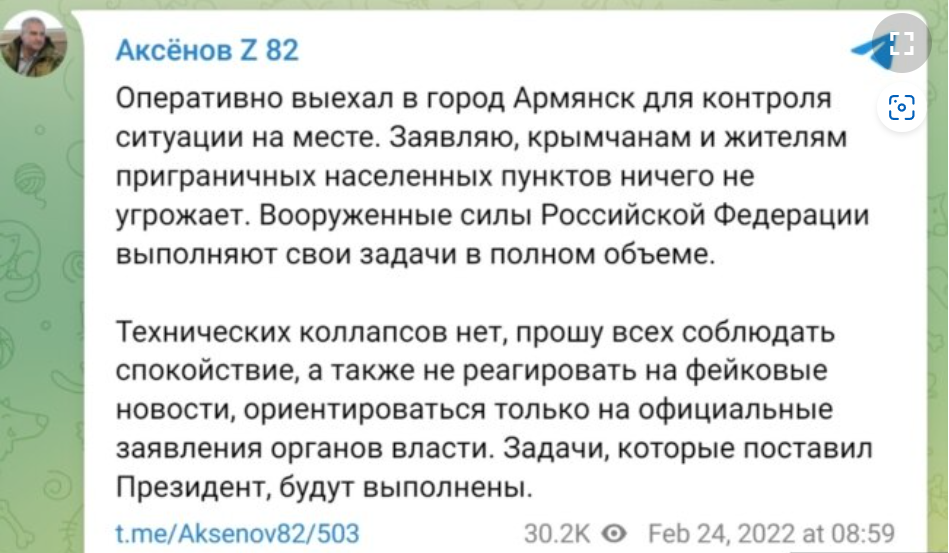
However, as Western-supplied weapons prove effective, strikes hit Crimea, and the war’s social and economic consequences grow, the occupying authorities face increasing challenges. To quell potential discontent, censorship in Crimea is expected to tighten further.
Occupied parts of Donetsk and Luhansk oblasts
Since 2014, the Russian-occupied territories of Donetsk and Luhansk oblasts, known as the “Donetsk People’s Republic” (“DNR”) and “Luhansk People’s Republic” (“LNR”), have been exposed to centralized Russian propaganda. While some differences exist between the two regions, the media landscape allows for a joint analysis of key principles.
The “DNR” and “LNR” maintain a facade of independent media systems, but in practice, no free and independent media have operated there since 2014. Local “laws” declaratively establish democratic principles, but these are not upheld in reality.
The “Ministry of Information of DNR,” led by Natalia Pershyna and Artem Olkhin, and the “Ministry of Digital Development, Communications and Mass Communications of LNR,” led by Andrei Yershov, Aleksandra Veselova, and Vladimir Kharitonov, control the media space in the “DNR” and “LNR.” However, these bodies lack true authority, fully depending on the Russian regime to execute Kremlin-designed information influence.
Censorship and limited access to Ukrainian and Western media have been extensively implemented. Ukrainian media infrastructure was seized in 2014, with outlets being blocked, closed, or exiled. Russian media flooded the information field, while new local pro-Russian media were developed under the control of occupying authorities.
In the “DNR,” key media outlets include TV channels like Pervyi Respublikanskiy and Oplot TV, print press such as Golos Respubliki and Donetsk Vecherniy, and radio stations including Respublika and Stolitsa. In September 2023, all local media were set to form a “Republican Media Holding” to further centralize control.
In the “LNR,” key traditional media include TV channels like Luhansk 24 and Televizionnaya initsiativa molodezhi, print press such as Respublika, Nasha Gazeta, and Vecherniy Luhansk, and radio stations like Luhansk and Svoyo Radio. The Luhansk Information Center, led by Sergey Meshkovoi, serves as a focal point of communications in the region.
Online media, particularly Telegram, play a crucial role in the media ecosystems of both the “DNR” and “LNR.” In the “DNR”, the top Telegram channels include Typical Donetsk, Incident Donetsk Z, and Vacancies in Donetsk, all of which have a pro-Russian affiliation. Other notable channels include Pushylin D.V., the personal channel of the so-called “head of DNR,” and Military Z Donetsk, which focuses on military news.
In the “LNR,” top Telegram channels include Vacancies in Luhansk, Separ ZOV Luhansk Donetsk, and Incident Luhansk | LNR, all of which have a pro-Russian affiliation.
The Union of the Donbas Volunteers, linked to Russian oligarchs and intelligence, unites militants from the 2014 hostilities and maintains a presence in the local information field through Russian social media VK and Telegram, recruiting volunteers to fight for Russia.
Russian GONGOs and cultural centers like Russkiy Mir (Russian World) and Russkiy Dom (Russian House) also exert influence, promoting historical disinformation and soft propaganda through cultural tools.
The Russian occupiers are exploiting Ukrainians’ vulnerable psychological state to crush resistance and ensure loyalty in the invaded territories. One false narrative is that Ukraine will brutally repress the population once it liberates the occupied areas.
To lend credibility to this, Russian propaganda has circulated a fake Naftogaz (Ukraine’s state energy company) utility bill offering discounts to customers who “turn in” alleged collaborators or draft dodgers. However, Naftogaz has refuted this, clarifying discounts are based solely on timely payments, not denouncing neighbors.

Occupied part of Zaporizhzhia Oblast
Over 50% of Ukraine’s Zaporizhzhia Oblast remains under Russian occupation, with key cities like Berdiansk, Melitopol, and Enerhodar seized. The region is now divided, with Ukrainian-controlled areas having access to Ukrainian and Western media, while the occupied territories are subjected to Russian censorship and propaganda.
After the occupation, Russian forces shut down several Ukrainian TV providers in the region, including Melitopol, MTV Plus, TV-Berdiansk, YUG, and Enerhodar Television systems. Notably, the Russian-appointed “governor” Yevhen Balitskiy gained control over MTV Plus to spread propaganda.
A similar approach targeted print media, turning outlets like Melitopolskie Vedomosti into propaganda tools after kidnapping the original publisher Mykhailo Kumok and journalists.
New pro-Russian media emerged, including TV channels Melitopol TV, Za!TV; radio Za!Radio; and newspapers Melitopolskie Vedomosti, Zaporozhskaya Pravda, and the local branch of Russian propaganda outlet Komsomolskaya Pravda – Zaporozhye.
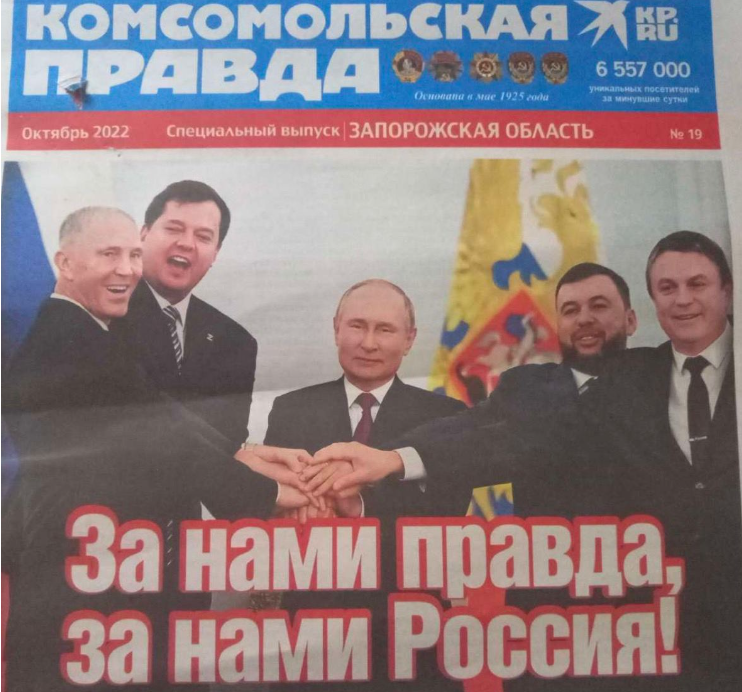
Za!TV and Za!Radio are part of ZaMedia, controlled by Russian propagandist Aleksandr Malkevich with ties to Wagner group’s Evgeny Prigozhin. Malkevich launched a “journalism school” to train propagandists, and is a leading figure influencing media in the newly occupied territories of Ukraine.
Key people enabling ZaMedia include Vadim Kucher (owner), Vadim Ivanov (director of Za!TV), and propagandists Egor Poberey and Vladimir Andronaki. Local collaborators working for new propaganda outlets include Dmytro Pereverzev, Dmytro Pysanets, Serhii Mnazkanov, Hennadiy Nikitenko, and Vadym Konovalsky.
The Zaporozhye News Agency, launched in July 2023 with occupying authorities’ support, is linked to similar agencies in other occupied territories. It broadcasts news from Russian national sources and is closely linked to ZaMedia.
Social media, particularly Telegram channels like those of Vladimir Rogov and Evgeny Balitskiy, have been crucial for spreading Russian propaganda in the region. These sources aim to portray Ukraine as abandoning locals while depicting Russia as a benevolent protector.
Occupied part of Kherson Oblast
Up to 30% of Ukraine’s Kherson Oblast remains under Russian occupation, covering 49 territorial communities. Henichesk was declared a temporary administrative center by the occupiers. In September 2022, Russia staged an illegal “referendum” and declared the region part of Russia, despite lacking full control.
Ukrainian collaborator Volodymyr Saldo leads the local occupying authorities, with many positions filled by Russian nationals, allowing Moscow to establish full control over the local agenda. Russia’s playbook in the region is similar to tactics used in the occupied part of Zaporizhzhia Oblast.
To establish influence, Russian occupying authorities prioritized seizing local media infrastructure. Prior to the occupation, there were 6 local TV channels and 15 radio stations in Kherson Oblast. The only local TV channel that initially collaborated was VTB+, led by Tetyana Kamenska. Soon after, TV channel Krat, owned by Vyacheslav Horlovsky, also became collaborative.
The office of the local branch of Ukraine’s public broadcaster Suspilne TV was captured and used as a basis for Tavria TV, a new local propaganda channel established by Russian propagandist Aleksandr Malkevich, a key figure controlling media in occupied parts of Kherson and Zaporizhzhia oblasts.

Over 20 Russian national channels were broadcast in the region, substituting access to Ukrainian and Western media. Local media were repurposed for propaganda or new outlets were created, often through kidnapping, blackmailing, and threatening local media workers, including torture as evidenced by journalist Oleh Baturin.
Malkevich established “journalism schools” and brought in media workers from Russia and other occupied territories to facilitate propaganda. The occupying administration’s newly established “Ministry of Information Policy” and “Ministry of Digital Development” had minimal influence compared to Malkevich.
Pro-Russian media in the region include TV channels Tavria TV, VTB+, Krat, and Kherson24, print press Mayak and Naddnepryanskaya Pravda, local media from Crimea and the “DNR”/”LNR”, and Russian national media.
Online, the occupiers launched the Kherson News Agency and the website ZOV.Kherson, featuring rankings of influential media figures, including some Ukrainian individuals.
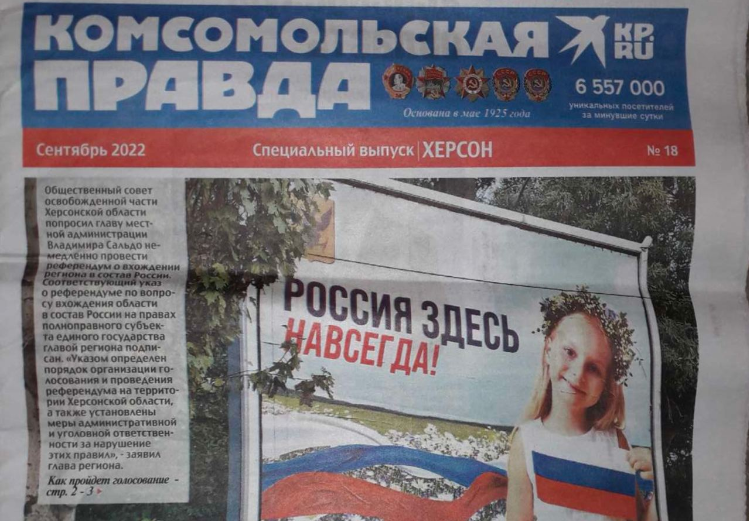
The liberation of Kherson city changed the media landscape substantially. Only around 80 pro-Russian Telegram channels remain active out of several hundred during the early invasion stages. These sources initially promoted the narrative of “Russia is here forever,” which was severely undermined by the Russian withdrawal and Ukrainian liberation of Kherson city.
Ukraine’s lessons for the EU
Russia’s influence differs in the EU and Ukraine, with Ukraine being a strategic goal of paramount importance for Russia. In the EU, Russia’s influence is facilitated by pro-Russian sentiments among elites and energy dependence. In Ukraine, Russia’s influence is stronger due to shared history and cultural space, targeting the Russian-speaking population.
According to Oleksandra Tsekhanovska, Ukraine’s experience in fighting Russian disinformation is relevant for EU countries, especially the Baltic states, which are already learning from it. The main lesson is that disinformation has real-world consequences and can cost lives.
“I recommend mapping Russian influence actors in interested countries to understand their networked approach and various destabilizing activities. Combating disinformation alone is ineffective; the full scale of their influence must be countered as a whole,” said the researcher.

Russian disinformation is part of a multi-faceted approach to influence other countries, alongside cultural influence, expert events, political assassinations, and funding illegal armed groups. Mapping these actors and activities is crucial, and government bodies should take responsibility as systemic changes require state-level involvement.
“Ukraine has two such institutions: the Center for Strategic Communications and Information Security, and the Center for Countering Disinformation under the National Security and Defense Council. Established after 2014, they were operational and had gained public trust well before the 2022 full-scale invasion,” the expert explained.
Encouraging governments to limit the spread of disinformation raises concerns about freedom of speech. Striking a balance between combating disinformation and safeguarding free speech is challenging, and not all countries are prepared to implement similar practices.
However, focusing solely on content to define disinformation is futile, as its forms continually evolve, especially with advancements in AI. A more effective approach is to identify and hold accountable organizations that consistently disseminate manipulative, deceptive, or false information leading to negative consequences.
“Countering hostile narratives requires developing our own narratives rooted in reality. Responding to lies with more lies only serves Russia’s strategic goal of undermining critical thinking and trust in institutions, creating a chaotic world where everyone has their own truth and acts without constraint,” Tsekhanovska warns.
Countering Russian disinformation is a challenge requiring systematic efforts, but political competition often hinders a coherent, long-term approach. Overcoming this demands strong political commitment to prioritize the fight against disinformation above partisan interests and foster a collaborative, society-wide response.
Read more:
- Report: Western media underestimate Russian propaganda’s effectiveness
- Russian war propaganda: strategic/tactical narratives, and their audiences
- “Old Guard” stands with Putin’s propaganda in France
- Russia’s propaganda war: How Putin bought Germany
- Where Putin’s propaganda on Ukraine has worked even better than in Russia: Germany
- From Soviet flags to TikTok stars: How Russia poisons Italy across generations
You could close this page. Or you could join our community and help us produce more materials like this.
We keep our reporting open and accessible to everyone because we believe in the power of free information. This is why our small, cost-effective team depends on the support of readers like you to bring deliver timely news, quality analysis, and on-the-ground reports about Russia's war against Ukraine and Ukraine's struggle to build a democratic society.
A little bit goes a long way: for as little as the cost of one cup of coffee a month, you can help build bridges between Ukraine and the rest of the world, plus become a co-creator and vote for topics we should cover next. Become a patron or see other ways to support.


